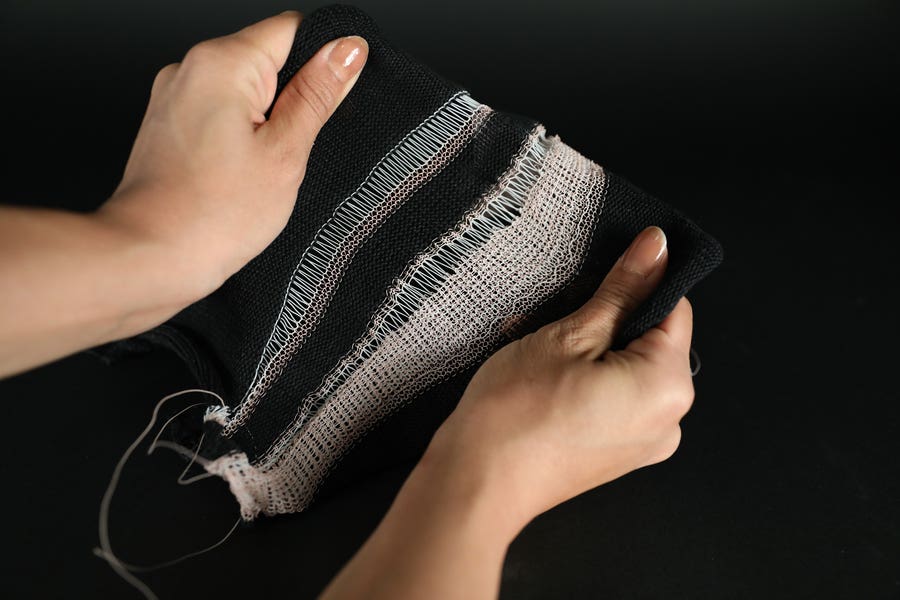Researchers develop smart clothing fiber that can adapt with temperature
Imagine a world where your coat adapts to the shifting seasons. As winter’s chill sets in, the fabric could tighten, increasing insulation.

[Oct. 30, 2023: Staff Writer, The Brighter Side of News]
Researchers from MIT and Northeastern University developed a liquid crystal elastomer fiber that can change its shape in response to thermal stimuli. The fiber, which is fully compatible with existing textile manufacturing machinery, could be used to make morphing textiles, like a jacket that becomes more insulating to keep the wearer warm when temperatures drop. (CREDIT: MIT Researchers)
Imagine a world where your coat adapts to the shifting seasons. As winter's chill sets in, the fabric could tighten, increasing insulation, and during the balmy days of summer, it could loosen up, allowing a breezy comfort.
Scientists at MIT have taken a leap towards making this futuristic dream a reality, thanks to a revolutionary invention named 'FibeRobo.'
The Genius Behind FibeRobo
Developed by an interdisciplinary team from MIT, FibeRobo is a programmable fiber that responds to temperature variations. As the environment heats up, the fiber contracts, and then reverts to its original shape as the temperature drops. What's incredible is that this dynamic change requires no sensors or rigid components, making the fiber uniquely versatile.
The fiber contracts in response to an increase in temperature, then self-reverses when the temperature decreases, without any embedded sensors or other hard components. (CREDIT: MIT Researchers)
Jack Forman, a graduate student affiliated with MIT's Tangible Media Group and the Center for Bits and Atoms, commented, "So much of our environment is adaptive and responsive, but textiles — a core part of our everyday lives — have remained inert." Forman spearheaded the study, collaborating with researchers from both MIT and Northeastern University.
The Science Behind The Fiber
At the heart of FibeRobo is a material known as liquid crystal elastomer (LCE). This is a special kind of substance that behaves like liquid but can arrange itself in crystal patterns. When heated, the crystal structure disrupts, causing the elastomer — which is stretchy like a rubber band — to contract. As it cools down, the fibers return to their original state.
The MIT researchers used FibeRobo to demonstrate several applications, including an adaptive sports bra made by embroidery that tightens when the user begins exercising. (CREDIT: MIT Researchers)
To create fibers appropriate for wearable use, the MIT team needed to ensure they could work at skin-friendly temperatures. Forman detailed the intensive process behind this, stating, "There are a lot of knobs we can turn. It was challenging to devise this process, but it provides us immense flexibility for the resulting fiber."
Challenges and Triumphs in Fiber Creation
Developing the perfect fiber wasn't without its challenges. Many attempts resulted in unusable masses of material. However, perseverance and innovation prevailed. Forman designed a machine that, using 3D printed parts and rudimentary electronics, transformed thick LCE resin into wearable fiber. The process is meticulous, with UV lights curing the fiber to achieve optimal consistency, followed by oiling and further curing to produce smooth, sturdy fibers.
Related Stories
From chemical synthesis to the final spool, this machine churns out approximately a kilometer of ready-to-use fiber within a day. Forman remarked on the importance of creating a reliable fiber, emphasizing, "At the end of the day, you want a fiber that seamlessly integrates with other materials but boasts new, exciting capabilities."
MIT's invention isn't just for coats. They've demonstrated its potential in sportswear, with an adaptive sports bra that adjusts its fit when the user exercises. Another innovative application was a compression jacket for Forman’s dog, Professor. Using Bluetooth, the jacket can "hug" the dog, offering comfort – a boon for pets prone to separation anxiety.
What makes FibeRobo even more groundbreaking is its cost. At 20 cents per meter, it's approximately 60 times cheaper than existing shape-changing fibers. Its compatibility with current textile manufacturing techniques, including industrial knitting machines and traditional looms, means that it can be integrated effortlessly into various clothing items.
They also used an industrial knitting machine to create a compression jacket for lead author Jack Forman’s dog, whose name is Professor. The jacket would actuate and “hug” the dog based on a Bluetooth signal from Forman’s smartphone. (CREDIT: MIT Researchers)
Looking ahead, the MIT team envisions making FibeRobo recyclable or biodegradable. Forman expresses his hope that FibeRobo becomes accessible to everyone — as easy to purchase as a ball of yarn — allowing DIY enthusiasts and professionals alike to produce adaptive textiles.
Lining Yao, a professor at Carnegie Mellon University who wasn't involved in the research, appreciated the innovation, noting, "LCE fibers come alive when integrated into functional textiles. It's fascinating to see how the authors have experimented with different textile designs."
In essence, FibeRobo signifies a paradigm shift in the world of textiles, merging the realms of science, technology, and fashion in a way that holds transformative potential for the future.
For more science and technology stories check out our New Discoveries section at The Brighter Side of News.
Note: Materials provided above by The Brighter Side of News. Content may be edited for style and length.
Like these kind of feel good stories? Get the Brighter Side of News' newsletter.



